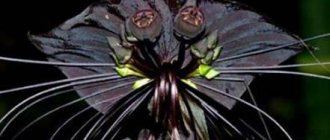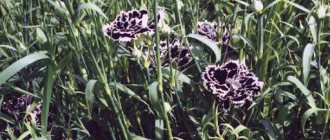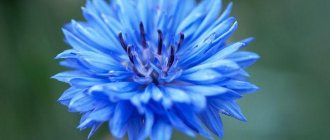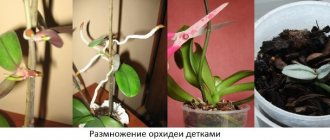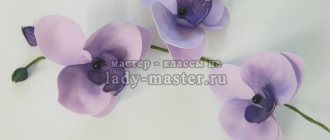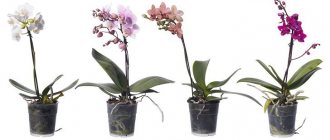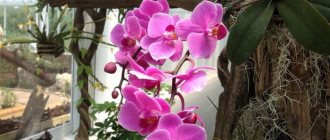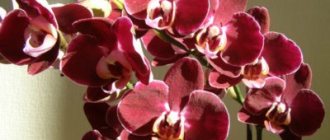The orchid has long become a familiar resident of our apartments and houses. They give it as a gift for holidays, collect it, and don’t think about what it looks like in the wild.
It is important for owners of each domesticated species of orchids to know what the conditions of their natural growth are.
Knowing in which country representatives of a particular species grow, the florist will better understand what an exotic beauty needs.
Orchids in nature: how and where do they grow?
The orchid is a very common plant and can be found around the world in 35,000 varieties. They can be found on all continents in tropical and temperate latitudes.
The largest number of species of these beautiful plants grow in the tropics. These conditions are most suitable for orchids.
Orchids need warmth and humidity. With their special root system, wintering in cold regions is impossible, so in apartment conditions it is important to prevent frosty air flow.
Saprophytes
This species is unusual in its appearance. Saprophytes are not like the phalaenopsis we are used to. These orchids do not have leaves, grow on the ground and have deep, thick roots. Outwardly, they look like corals and do not create thin processes.
They form a symbiosis with mycelium , feeding on substances and water from humus and peat. The orchid has a thin stem covered with scales. The flowers are small and inconspicuous.
Saprophyte Common nester (photo in natural conditions).
The absence of leaves and chlorophyll allows the plant to live in shady places under the canopy of trees.
Epiphytes
Orchids of this group are the most familiar and familiar to all gardeners. Common species such as phalaenopsis and vanda are epiphytes.
Epiphytes do not grow on the ground. Their roots contain velamen, which absorbs water like a sponge. In an effort to hide from herbivores and excess water, the orchid climbs onto vertical supports. It can grow on a tree or stone.
Many people incorrectly believe that epiphytes are parasitic. Being on a tree, the orchid does not harm it and does not damage the bark. Receives water from the environment. Warm tropical rain, morning dew and fog satisfy the plant's fluid needs. Thick leaves and roots are able to retain moisture for a long time, so epiphytes are not afraid of unexpected drought.
The abundance of colors and shapes makes the flowers of these orchids attractive to insects, and the climate conditions are ideal for propagation by seeds. Under natural conditions, orchids easily form seed pods , their flowers are large, and their leaves reach a length of thirty centimeters.
Epiphyte Vanda (photo in the wild).
Epiphytes bloom all year round , forming long inflorescences. Seeds remain viable for up to 2 years, because even in ideal conditions it is difficult to find a suitable place for a sprout.
Interesting! Epiphytes do not need soil or peat. They have adapted to live in trees, using them as support.
Ground
Such plants have green shoots and roots buried in the ground. Just like epiphthites, their roots have velamen and no small shoots. Such a root system needs light soil with a high air content.
Terrestrial orchids prefer the top layer of light forest soil. It consists of moss, bark and peat. Water does not stay here for long, so this composition is ideal for terrestrial species.
The height of these plants in natural conditions can be above 60 cm. As the root system grows, it produces new shoots, so the orchid looks like a huge bush with many flowers. Each trunk blooms only once in its life and devotes all its strength to the formation of seeds and the growth of new shoots.
Terrestrial orchid Cymbidium (photo in its natural environment).
Orchids of this species are able to accumulate water in thickened shoots or pseudobulbs. In unfavorable periods, some of them shed their leaves and lose part of the root system.
Prominent representatives of terrestrial orchids include:
- Cymbidium;
- Miltonia.
Wild orchids of temperate latitudes
The vegetation of temperate latitudes also boasts extraordinary orchids, although not as charming as American or Asian ones, but incredibly charming. They have their own special northern beauty, captivating with their endurance, resistance to cold and stunning grace.
The most striking representatives of terrestrial orchids growing in rather harsh climatic conditions of the temperate zone:
Large-flowered pollenhead (Cephalanthera damasonium) and red pollenhead (C. rubra) are spectacular plants that are disappearing in nature due to the fact that they are collected en masse for bouquets. The red pollenhead has a much wider distribution area, covering almost all of Europe and the temperate zone of North America.
Cephalanthera damasonium
The most fragrant Kokushnik (Gymnadenia odoratissima) is an orchid with a very delicate pinkish inflorescence with a vanilla aroma, which appears no earlier than 5–7 years of age. A distinct calciphylla, growing in calcareous bogs throughout Western and Eastern Europe.
Gymnadenia odoratissima
Dark red nappet (Epipactis atrorubens) is a pubescent plant with foliage covered in a purple tint. An inflorescence with small dark cherry flowers that smell of vanilla rises almost 60 cm above the soil level. Grows in Iran, Western Siberia, Asia Minor, and Europe.
Epipactis atrorubens
Calypso bulbosa - lives in the cold regions of North America and Europe, reaches a height of 8–20 cm. The flowers are open, dark pinkish, with a light shoe-shaped lip speckled or striped.
Calypso bulbosa
The lady's slipper (Cypripedium calceolus) is a universal favorite, distributed across Eurasia from the Pacific coast to the British Isles. Popular in garden floriculture.
Cypripedium calceolus
Lyubka bifolia (Platanthera bifolia) is a medicinal plant that has long been used in folk medicine. Due to its highly decorative qualities, it is used in cultural cultivation in temperate latitudes of Europe and Asia Minor.
Platanthera bifolia
Anacamptis Pyramidalis is a meadow orchid with a delicate aroma and a lush multi-flowered purple inflorescence. In the natural environment it grows from the Mediterranean to Iran.
Anacamptis pyramidalis
Comperia comperiana - found naturally off the southern coast of Crimea, in Turkey, Iraq and Western Iran. It has unusual, delightful flowers with four thread-like appendages up to 8 cm long, flowing from the lip blades.
Comperia comperiana
Traunsteinera globosa - lives in alpine meadows on the mountain slopes of Europe and Asia Minor. Large spherical inflorescences of purple color rise on peduncles growing up to 70 cm high and are visible from afar.
Traunsteinera globosa
Fuchs' fingerroot (Dactylorhiza fuchsii) is a Red List species protected in many regions of the European part of Russia and Siberia, growing in Ukraine and Northern Mongolia. A bright orchid with expressive lilac-pink inflorescences 6–14 cm long. The lip is lighter with a sharply defined purple pattern.
Dactylorhiza fuchsii
Frequently occurring species
Royal
The royal orchid is a large-flowered variety of phalaenopsis . It is distinguished by its large flower size (from 10 cm), long peduncles and wide leaves.
In the natural environment, phalaenopsis of this size is difficult to find, since this is the result of selection. However, it can be found in the tropical forests of India, Indonesia and China, provided many factors coincide.
The epiphyte is demanding of bright light and nutrients. If one of the conditions is lacking, the plant produces smaller flowers.
The peduncle of the royal orchid reaches a height of 1.5 m and can branch. Smelling representatives are often found.
Flowering lasts up to 7-8 months. It takes a lot of energy for the plant to maintain large flowers, so a second peduncle appears extremely rarely.
Lyubka bifolia
The plant is often found in temperate forests and has a second name - night violet. It has an unsightly appearance, small white flowers and a delicate aroma that attracts insects.
This is one of the wintering orchids. It survives frosts due to the presence of a tuber, which is a thickening of the root for the accumulation of nutrients. It forms a symbiosis with the mycelium and is renewed every year by dying and growing a new one. Young tubers can be collected for medicinal purposes.
Lyubka bifolia.
Flowering period: May, June. It forms seed pods in August; the leaves and peduncle die off in the fall.
Reproduction occurs only with the help of seeds, so collecting the flowers of Lubka bifolia leads to the extinction of the species.
Attention! Lyubka bifolia is an endangered species and is prohibited for collection in the forests of Russia.
Lady's slipper
The plant got its name due to the unusual shape of the petal. The lower part of the stigma was formed as a result of the fusion of two petals, which formed a “shoe”. There is a legend about the goddess Venus, who lost her shoe while walking in the forest.
Natural habitat is temperate forests . The plant is capricious and is on the verge of extinction due to collection. Listed in the Red Book.
It is rarely possible to see a lady's slipper in its natural form. It can be found in nature reserves, botanical gardens and places where people rarely go.
The plant is shade-loving and requires moisture . Grows only in light soil with neutral pH and high lime content.
Reproduction is vegetative and seed , which facilitates the spread of the species.
Interesting Facts:
- Long-lived. Lives up to 100 years or more;
- For seed germination, mycelium is necessary;
- Prefers to be adjacent to both pine and birch trees;
- Flowers are formed only in mature plants that are more than ten years old;
- Is on the verge of extinction;
- It has a second name - Russian orchid.
The lady's slipper is protected in all European countries.
The lady's slipper has different colors . Its flowers can be yellow-burgundy, pink, white and green with various spots and wavy shape of the petals, exuding a pleasant aroma.
Orchis spotted
The medicinal plant spotted orchis is familiar to many gardeners as “cuckoo tears.” Unlike most orchids, it prefers clayey, swampy soils . The plant is distributed throughout Russia, excluding the Far North region.
The root system forms a tuber that accumulates nutrients and easily survives the cold. With the arrival of spring, the bulb devotes all its energy to growing flowers, leaves and a new nodule.
The orchis tuber is collected for medicinal purposes , as its pulp contains a large amount of useful substances. The bulb is edible and its nutritional value can last for the whole day.
Good to know! Spotted orchis survives transplantation well and is easily “cultivated.”
It blooms in early summer with small lilac flowers . By August, ripe seeds are formed, however, in order to germinate, they need symbiosis with the mycelium. In addition to seeds, it reproduces vegetatively.
goodyer repens
Found in coniferous forests of the Moscow region . Its peculiarity is a creeping rhizome, with the help of which it reproduces.
A special feature of this orchid is its ability to go underground . When there is not enough light for the growth of green shoots, it turns into a saprophyte, forming a symbiosis with bacteria and fungi.
After improving the lighting, it produces greenery and blooms. If conditions have not changed, then it dies.
Nest
Common nesting plant is an unusual plant. His appearance does not remind her of her beautiful relatives. The plant has no green leaves and is a saprophyte . Its main color is brown.
The roots form a tight bunch, reminiscent of a bird's nest. Because of this feature, the nesting site got its name. From the roots come yellowish-brown shoots with a cluster of flowers emitting a sweet aroma.
Interesting! The common nester reproduces only with the help of seeds, of which more than 10,000 are produced per flowering.
Adaptation to the environment
Orchids grow almost all over the globe, with the exception of the poles. Therefore, they can be found in these places:
- On the trees. Orchids with an epiphytic lifestyle grow on the tree table. They attach themselves to the surface of the plant with their roots, so they prefer species with rough bark. Moisture and humus collect well in its cracks. Reproduce by seeds and layering;
Orchids can grow on trees (photo of phalaenopsis).
- On the rocks. Lithophytic orchids are found on rocks and cobblestones. Their roots are very delicate and do not tolerate stagnant water. They reproduce by rhizomes and seeds;
- On the ground. Some types of orchids grow on the peat substrate of the forest. They form a symbiosis with the mycelium, receiving nutrients from it. They reproduce by seeds, sometimes by tubers and layering.
Classification of orchids
Tropical
Flower growers were able to “domesticate” some orchids and establish rules for their cultivation. Flowers found in stores:
- Dendrobium;
- Phalaenopsis;
- Cattleya;
- Cymbidium;
- Miltonia;
- Wanda;
- Oncidium;
- Cumbria.
Let's look at some of them in their natural habitat.
Dendrobium
As the name suggests, the orchid likes to use trees for support . There are more than a thousand species of dendrobium. They vary in flower shape and size, stem height and behavior throughout the year. Many species shed their leaves and have a dormant period.
Dendrobium kingianum.
Cattleya
In its natural environment, cattleya grows on trees and rocks. The life cycle has three phases: flowering, dormancy, active growth. The flowers are large, of different colors, and have a velvet covering. Look below at the photo of how orchids grow in the wild.
Cattleya.
Phalaenopsis
It is also called the beginner's orchid. This tropical beauty grows in nature on trees, absorbing water from the environment. The roots of the plant are involved in photosynthesis and moisture accumulation. Phalaenopsis flowers, similar to a butterfly, attract with their beauty and size.
Phalaenopsis in nature.
The most unusual
The unusualness of these orchids is due to the shape of their flower. They amaze the average person with their appearance. Many gardeners would like to have them in their collection. Next you can see photos of orchids growing in the wild and read their description.
Peristeria tall (dove orchid)
The orchid has snow-white flowers whose central petals resemble the shape of a dove.
The orchid blooms very rarely (after reaching 10 years of age) and has from 2 to 5 buds.
The stem forms a large pseudobulb that accumulates water. The orchid leaves reach one meter, and the flowers are 6 cm.
Interesting! The birthplace of Peristeria alba is Panama. There she is revered as a national symbol and a symbol of peace.
Caladenia melamena (ballerina orchid)
The unusually shaped flowers of this plant resemble a ballerina in a white tutu and with her arms raised. The orchid is very rare and grows only in Australia.
Caladenia melamena.
Kaleana (duck orchid)
The miniature flowers of this plant are only 2 cm long . Kaleana is a terrestrial orchid. Prefers to grow in tall grass in Australia. Loves proximity to eucalyptus.
The shape of the flower is similar to the delicate shape of a duck with delicate thin wings and a well-defined head. The flowering period lasts from September to January.
Kaleana.
Anguloa uniflora (babies in diapers)
The orchid grows in the high mountain forests of South America. During a certain flowering period, the pink and white petals fold into a shape similar to a swaddled baby. At this moment the flower has a bright sweet aroma.
Anguloa single-flowered.
Habenaria radiata (heron orchid)
This orchid is called the oriental beauty. Its habitat is the marshy areas of Japan, China and Korea.
The snow-white petals of the orchid are shaped like a heron that has spread its wings. During the dormant phase it sheds its leaves.
It is very popular in Japan and successfully bred at home.
Habenaria radiata.
Dracula Orchid
The second name of this plant is monkey orchid. The central part of the burgundy flower has a contrasting white color. It is shaped like a monkey's face. Grows in South and Central America.
The epiphyte has more than a hundred species. They have different flower appearance. Color varies from white to dark brown.
Dracula Orchid.
Risantella gardner (subterranean orchid)
One of the most amazing orchids. If you meet it in its natural environment in Australia, you would not think that this plant is an orchid. Forms a symbiosis with shrubs from the myrtle family through the mycelium of the fungus Thanatephorus gardneri.
Has no leaves. A white and pink inflorescence with many burgundy flowers rises above the ground. Has a sweet aroma.
Risantella Gardner.
Growing in temperate latitudes
Despite the huge abundance of tropical beauties, orchids are also found in temperate latitudes.
Pollenhead
The plant is found in dry shady forests of mountainous regions. To obtain nutrients, it forms a symbiosis with mushrooms. Propagated by root shoots and seeds. There are small-flowered and large-flowered species.
Pollenhead.
Interesting! Flowers have no nectar.
Kokushnik
Small flowers appear only after 5 years of life and have a subtle vanilla aroma.
The root system looks like a system of tubers that interact with the mycelium.
Kokushnik.
Dremlik
Dremlik marsh prefers marshy areas . Forms inflorescences with small beautiful flowers. It blooms in mid-summer and attracts insects with its intoxicating smell.
It is a light-loving plant, so it can only be found in open areas.
Dremlik swamp.
Calypso bulbous
A delicate orchid that loves solitude, grows in cool, damp areas . Prefers open forests.
It blooms in early spring and easily withstands late frosts. It produces a single leaf, which dies after flowering.
Calypso bulbous.
Anacamptis pyramidalis
The plant belongs to the orchis species . It has wintering tubers and a long stem reaching a height of up to half a meter.
It reproduces by seeds, of which a lot is produced. They are similar in size to dust particles and are spread by the wind.
Anacamptis pyramidalis.
Comperia compera
It has unusually shaped flowers. Tendrils extending from the petals hang down. Because of its appearance, the orchid is loved by flower growers and florists.
Distributed in Crimea.
Comperia compera.
Traunsteiner spherical
Grows on the damp mountain slopes of the Caucasus and Crimea . It is also found in other regions of Russia and Ukraine.
Traunsteinera is spherical.
High quality images of the world's most stunning views
Brassavola
Found in Central and South America, it unites about 20 species of orchids. It is called Lady of the Night because at night it emits a strong aroma that attracts pollinators.
The flower may be yellowish, white or greenish. Large lip in contrasting color with fringe and pink spots.
Vanda
Vanda is an epiphytic plant, has aerial roots, and usually grows on rocks or trees.
These orchids can be found in India, Thailand and southern China. The peculiarity of the species is that it has a monopodial growth pattern, the stem stretches only upward, its height can reach several meters. Among the varieties you can find bright and unusual colors, such as blue or purple.
Read about the varieties of Vanda orchids here.
Epidendrum
Numerous genus of the orchid family. Found naturally in the subtropics and tropics of America. Despite the fact that epidendrum has a large number of subspecies, there are few hybrids among them, since the flower is practically impossible to cross.
The species differ from each other in almost all characteristics: height, the presence of pseudobulbs, buds, etc. They are similar only in that they have a large section of the lip fused with the column.
Brassia
The flower of this species is called “spider orchid”. This name is due to the fact that the orchid has unusual yellow flowers, on the surface of which there are convex brown specks. Found in the tropics of America: the Brassia orchid prefers to grow in humid forests.
Read more about Brassia spider orchid varieties in this article.
Angrecum (Angraecum)
Includes about 200 species. Grows in tropical humid areas of Africa and the islands of the Indian Ocean. Angrecum flowers are star-shaped and white.
As for size, they can be either small or large. The surface of the leaves is covered with a waxy coating. It blooms in winter for a month and has a pleasant aroma with notes of cinnamon; the smell intensifies at night.
Paphiopedilum
It is also called Lady's slipper, as the flowers look like a woman's slipper. It is found naturally in New Guinea, the Philippines, Thailand, China, and India. What varieties and hybrids of paphiopedilum can be grown at home can be found here.
Miltassia
It has large star-shaped flowers with flattened pseudobulbs.
It is a hybrid obtained by crossing Miltonia and Brassia.
It belongs to the types of orchids with a strictly defined cyclical development. The flowering process begins after a dormant period. The flowers have different colors, depending on the variety, but each is characterized by the presence of stripes or inclusions.
Odontoglossum
Perennial herbaceous plant, includes about 65 species. Grows in the mountains of Central and South America. Read more about odontoglossum here.
Schomburgkia
Grows in the tropics of America, Mexico, and India.
Schomburgkia loves light and high humidity, but does not like heat. It has a long peduncle, at the top of which there are branched inflorescences, the pseudobulbs are oblong and look like a bunch of bananas. There are white, yellow, pink, burgundy shades. During flowering it increases in size.
Schomburgkia buds are of an unusual shape, more like alien creatures than earthly flowers: the petals are corrugated, and the lip is wrapped in a tube.
As a result of crossing with laelia, brassavola, cattleya, epindendrum, beautiful and less whimsical hybrids were obtained.
Miltonia
A herbaceous perennial plant, it can be found in the forests of Brazil and Colombia, preferring to grow in lowlands and in places with a rainy climate. It has false bulbs, from which stems grow that look like a broom. The inflorescences resemble the shape of a pansy flower.
The variety of Miltonia orchid varieties is described in more detail in this article.
Beallara
A hybrid obtained by crossing such representatives of orchids as Brassia, Odontoglossum, Miltonia. Most often in stores this type of orchid is called Brassia Cambria.
Beallara is a fairly large plant with star-shaped flowers. The flowers have a delicate color, for example pinkish, white, cream, with specks and spots scattered across the surface of the petals.
Cattleya
It includes about 40 species, among which there are both epiphytic and lithophytic. Grows in the countries of South and Central America: Brazil, Mexico, Argentina, Paraguay, Bolivia.
The difference from other species is that the orchid has a non-standard large lip, painted in a contrasting color. Also has an excellent aroma. Read about cattleya varieties here.
Laelia
Externally, the flower is similar to a cattleya, so they are often confused. However, lelia flowers are smaller in diameter and have a brighter color. The most important distinguishing feature is the number of pollen balls; Lelia has several times more of them. The growth pattern is sympodial.
In nature, this type of orchid is found in the subtropics and temperate regions of South America and western India. Usually in stores there is a hybrid of lelia, the peduncle of which can produce only one flower, but it is not difficult to purchase an orchid with many flowers.
Dendrobium
The perennial herbaceous plant includes more than 1,200 species, among which most of the flowers are epiphytes. Found in Australia, New Zealand, Japan, Oceania, China, New Guinea and the Philippine Islands.
Dendrobium is called an air flower, its stem length is from 0.4 to 0.9 m, on the peduncles there are many flowers with a pleasant aroma (usually from 1 to 4), the diameter of which is about 6 cm.
A lot of useful information about dendrobium varieties and caring for them is contained in this article.
Biffenaria
This genus includes 24 species of orchids. Found in tropical rain forests of South America.
Biffenaria is a small plant with olive-colored pseudobulbs with 1-2 lance-shaped leaves. During flowering it produces an aroma with notes of caramel. The buds open one after another, each of which blooms for 2 weeks.
Coelogyne
A very elegant orchid of snow-white color, thanks to its abundant flowering it resembles lace. It is found in tropical forests in the south and southeast of Asia, as well as on islands near the Indian and Pacific oceans. The genus Coelogina has more than 100 species.
Zygopetalum
The genus Zygopetallum is small in number, represented by epiphytes, but depending on the habitat they can become terrestrial or lithophytic plants. Found in tropical forests of America, the largest populations are in the rain forests of Brazil.
It differs from other types of orchids in its growth pattern: zygopetallum grows like a ladder, but at the same time it gradually forms a rhizome that rises above the ground.
The orchid has a large palette of colors, but each color is accompanied by bright splashes. It blooms in winter and has a memorable, pleasant aroma.
Oncidium
This genus includes a large number of plants that both have external differences and require different growing conditions.
There are varieties of oncidium that grow in arid savannas, others live in the warm forests of America, and some can be found in the mountains. The oncidium hybrid is very popular; it is characterized by the presence of a branched and long peduncle with small flowers of brownish-yellow or red color, which look like moths or butterflies.
Read more about oncidium varieties and hybrids here.
Calanthe
The genus Kalantha has about 100 species and grows in the tropics of Africa, Southeast Asia and Australia.
Kalantha is a deciduous plant; it sheds its leaves during the dormant period, but there are also evergreen species. This orchid has 3–4 herbaceous folded leaves, their length is 0.35 m, width is 0.1 m.
As for the color of the inflorescences, these are usually white or pink shades; violet-brown, bright yellow and red colors are less common. The shape of the calanth resembles a butterfly.
Phalaenopsis
The most common indoor flower, as it is easy to care for and has a long flowering period.
Grows in India and East Asia, the Philippines. The phalaenopsis orchid has a long stem with 3–5 large leaves. About 75 varieties of the flower are known, and the number of hybrids has long exceeded a thousand. Each has its own color, leaf size and butterfly shape of the petals.
Among the varieties, those that have bright colors or lush multifloral blooms stand out. But there are miniature varieties with a bud structure unusual for phalaenopsis.
Catasetum
Most often found in Brazil. It has a sympodial growth pattern. It differs from other types of orchids in that catasetum can have flowers of different sizes and colors on one plant.
This happens because two types of flowers develop: male and female. Male flowers are complex, large in size (10–12 cm) and bright in color; they appear due to lack of light. Women's ones are smaller and have a simple appearance; they appear in good lighting.
Catasetum is often affectionately called the carrot orchid.
Cymbidium
Cymbidium is an evergreen epiphyte that grows in the subtropical forests of Asia and northern Australia. It has a sympodial growth pattern, that is, the development of the flower occurs not thanks to the trunk, which does not even exist, but due to the appearance of new rosettes of leaves, on which a peduncle appears over time.
The latter can be of different shapes, for example straight, downward, curved, the flowering period lasts several months.
You can learn about the varietal diversity of cymbidium from this article.
Bulbophyllum
Includes about 2,000 species, each of which is different from each other. Sometimes it is difficult to imagine that two plants of this species are relatives, they are so different from each other. The size and shape of pseudobulbs, leaves, lips, and the period and duration of flowering differ. In most cases they are epiphytes.
Some members of the genus grow in warm temperate climates with humid air, others are located in the mountains with cool conditions. This type of orchid can be found in the tropics of America, Asia and the islands of Oceania.
Ludisia
The only representative of the monotypic genus of orchids. Found in tropical rainforests of Southeast Asia and Sumatra. It differs from other orchids in the bright color of its leaves. The flowers of Ludisia precious are small and small.
Lycaste
Includes more than 40 varieties, can be found in Central and South America, in India. Most representatives grow in the mountains, others on flat terrain.
It has ovoid pseudobulbs; after flowering the orchid sheds its leaves. There are several large flowers on the peduncle; their color depends on the variety. The main colors of the lycaste orchid are pink, orange, yellowish-green.
Cambria
A hybrid of Oncidium and Miltonia, which was bred specifically for indoor growing. It has a variegated color and blooms at any time of the year. Read about the Cambria orchid here.
Aganisia
Unites only 4 species of plants found in South America.
This is a small epiphyte with a long and thin stem, which is characterized by sympodial growth, and the flowers are star-shaped.
Most often you can find Blue Aganisia and Beautiful Aganisia on sale. This orchid does not have any smell. The flowering period occurs at the end of winter and beginning of summer.
Grammatophyllum
Grows in Thailand, Vietnam, the Philippines, and New Guinea. An epiphytic plant, located at an altitude of 500 meters above sea level.
Grammatophyllum is quite tall, its minimum height is 0.4 m. The flowers are red-brown or green-yellow. This species is characterized by the presence of a triple lip, its sides are slightly raised and resemble a helmet.
